Practice Exercises - Natural Selection - AP Biology Premium 2024
Practice Questions
Multiple-Choice
Questions 1 and 2
Drs. Peter and Rosemary Grant have studied the rate of evolutionary change in the finch populations of the Galapagos Islands. Beak size in these finches determines which types of seeds the finch populations feed on. Finches with larger beaks eat thick-walled seeds, while finches with smaller beaks eat thin-walled seeds. During a drought from 1981 to 1987, the number of plants that produced thin-walled seeds decreased. It was determined that the average beak size (both length and mass) of finches increased dramatically during the drought.
1. Which type of selection most likely led to the change in beak size during the drought?
(A) directional selection
(B) disruptive selection
(C) stabilizing selection
(D) sexual selection
2. During the years 1988 to 1995, the average beak size of the finches decreased. Which of the following is the most likely explanation for this change?
(A) Female finches prefer to mate with males with smaller beaks.
(B) The drought ended, and the average rainfall returned to predrought levels.
(C) Predator populations increased.
(D) Finches with larger beaks were more susceptible to diseases.
_____________________________________________________________________________
(A) DNA sequences
(B) fossil record
(C) habitat distribution
(D) mating behaviors
4. The following figure shows the bone structures of the limbs of a whale, a horse, and a human.
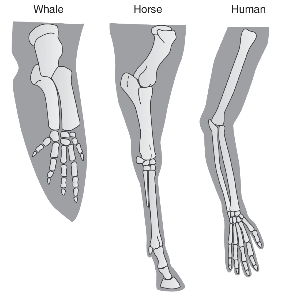
These are examples of which types of structures?
(A) analogous
(B) convergent
(C) homologous
(D) vestigial
5. Triclosan is an antibacterial chemical that is used in some household products to reduce bacteria levels. Which of the following is the most likely result of increased use of products that contain triclosan over time?
(A) All household bacteria species will be eliminated.
(B) Household bacteria species will become resistant to triclosan.
(C) Individual bacteria will learn how to resist the effects of triclosan.
(D) Increased triclosan levels will increase the frequency of mutations in household bacteria.
6. Snakes feed on toads. Cane toads (Rhinella marina) excrete a toxic substance on their skin that is poisonous to many, but not all, snake species. If cane toads are introduced to a new environment, predict the most likely effect on the snake species in that environment.
(A) All snake species in the environment will die out due to the cane toads’ toxin.
(B) Snake species that are resistant to the cane toads’ toxin will increase in numbers.
(C) Snakes that are susceptible to the cane toads’ toxin will acquire resistance to the toxin.
(D) All snake species will learn to avoid eating cane toads.
7. The human TAS2R38 gene encodes a cell membrane protein that influences the ability to taste bitter compounds. Individuals who possess at least one TAS2R38 allele have the “taster” phenotype and can taste certain types of bitter compounds. It is estimated that about 70% of humans have the taster phenotype. Which of the following best explains the frequency of the taster phenotype?
(A) Many toxic compounds have a bitter taste, so the TAS2R38 allele provided a survival advantage in ancestral humans.
(B) Ancestral humans with the TAS2R38 allele were more likely to consume bitter-tasting foods.
(C) Bitter-tasting foods have a higher nutrient content and were more likely to be consumed by ancestral humans who did not have the TAS2R38 allele.
(D) A lack of the TAS2R38 allele provided a survival advantage in ancestral humans.
8. The Aztecs were some of the first humans to slowly change teosinte, also known as wild corn, into the current form of corn eaten today. Which process did the Aztecs most likely use?
(A) artificial selection
(B) frequency-dependent selection
(C) natural selection
(D) sexual selection
9. Which of the following assertions (about how evolution by natural selection occurs) is incorrect?
(A) There are variations among individuals of a species.
(B) Some variations provide a survival advantage.
(C) Variations acquired during an individual’s lifetime are passed on to the individual’s offspring.
(D) Over time, the frequency of individuals with variations that provide a survival advantage will increase.
10. Rock pocket mice (Chaetodipus intermedius) are found in rocky outcrops in the desert of the southwestern United States. Some rock pocket mice have light-colored fur, while others have dark-colored fur. A population of rock pocket mice lives in a desert with both light-colored sand dunes and dark-colored rocks. Owls and hawks prey on the rock pocket mice they see. The initial ratio of light-colored to dark-colored mice in this population is approximately 1:1. A sandstorm occurs in the habitat of this population of rock pocket mice, and it covers all of the habitat in a thick layer of light-colored sand. Predict the most likely effect of this on the rock pocket mouse population.
(A) The relative frequency of dark-colored rock pocket mice would increase.
(B) The relative frequency of light-colored rock pocket mice would increase.
(C) The numbers of both dark-colored and light-colored rock pocket mice would decrease.
(D) The numbers of both dark-colored and light-colored rock pocket mice would increase.
Short Free-Response
11. Three new species (A, B, and C) of fossilized crocodile are discovered. The characteristics of these species are compared to those of the saltwater crocodile, Crocodylus porosus. The saltwater crocodile is found in Southeast Asia and Australia, and adults range in length from 5.5 to 5.8 meters and have 66 teeth. Data comparing the characteristics of the three fossilized crocodile species are shown in the table.
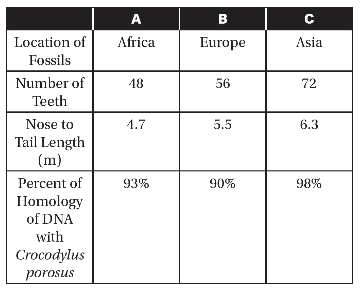
(a) Based on the data given, identify the fossil species that has the most in common with Crocodylus porosus.
(b) The number of teeth in a crocodile jaw correlates with increased predator efficiency. Identify the crocodile(s) that would be less efficient predators than C. porosus.
(c) Evaluate the claim that species B shares a more recent common ancestor with C. porosus than do species A or species C.
(d) Explain your reasoning for your response from part (c).
12. A student performs an experiment to study the effects of repeated exposure to antibiotics on bacteria. A strain of E. coli that is not antibiotic resistant is grown on an antibiotic-free LB agar plate (plate 1), the starter plate. Some of the E. coli from the starter plate are then spread on a plate that contains LB agar and 50 ug/mL of the antibiotic ampicillin (plate 2), and some of the E. coli are spread on a plate that contains LB agar without antibiotic (plate 3). E. coli from plate 2 are then spread on a plate that contains LB agar and 100 ug/mL of the antibiotic ampicillin (plate 4). E. coli from plate 3 are then spread on a plate that contains LB agar without antibiotic (plate 5). A diagram of the experimental plates is shown in the figure.
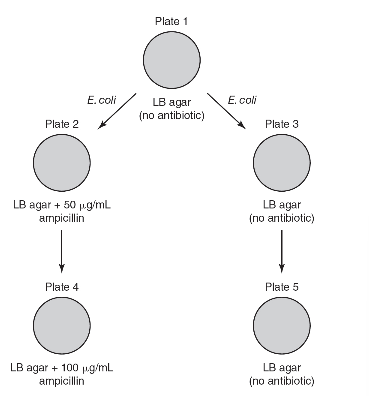
(a) Describe whether E. coli that are all susceptible to ampicillin, all resistant to ampicillin, or a mix of both will grow on the starter plate. Explain your answer using the principles of natural selection.
(b) Identify the plates that serve as controls in this experiment. Identify the independent variable in the experiment.
(c) Predict the relative amount of E. coli growth on plates 2, 3, 4, and 5.
(d) Justify your prediction from part (c).
Long Free-Response
13. Wild guppies (Poecilia reticulata) live in ponds on the island of Trinidad. Male guppies have great variation in the number and colors of spots, leading to a wide variety of color patterns among male guppies. Female guppies do not express these spots and are drably colored. Female guppies will more often choose to mate with males who possess bright color patterns. However, males with brighter color patterns are more visible to predators. An experiment was performed to measure the effect of the presence of a guppy predator (Cichlidae alta) on the number of spots in male guppies. Guppies were placed into two different environments: one with no predators and the other in which C. alta was present. Guppies were allowed to reproduce in both environments for 20 generations. After 20 generations, the number of spots on each male guppy was counted. The mean number of spots on male guppies is shown in the table.

(a) Describe the type of selection (directional, stabilizing, or disruptive) that is caused by the presence of C. alta.
(b) On the axes provided, construct a graph of the mean number of spots per male guppy for each group. Include 95% confidence intervals on your graph.

(c) Use the graph you constructed in part (b) to make a claim about the mean number of spots per male guppy in the no-predator environment as compared to the mean number of spots per male guppy in the environment with C. alta. Support your claim with evidence from the graph.
(d) As a follow-up experiment, some of the guppies in the environment with C. alta were removed and placed in an environment with no predators. They were allowed to reproduce for 20 generations. Predict what you would expect to happen to the mean number of spots per male guppy in this new predator-free environment after the guppies were allowed to reproduce for 20 generations. Justify your prediction.
Practice Questions
Multiple-Choice
1. In which populations is genetic drift more likely to occur?
(A) large populations
(B) small populations
(C) populations with great diversity
(D) populations with a high degree of gene flow
2. A group of birds is flying south during their yearly migration when a hurricane with extremely strong winds occurs. Only 10% of the group survive the storm, reaching their winter nesting site and reproducing the next spring. This type of event is an example of
(A) the bottleneck effect because only the fittest members of the population survived.
(B) the bottleneck effect because the population size was rapidly reduced.
(C) the founder effect because the group of birds from before the storm were not genetically diverse.
(D) the founder effect because the birds colonized a new habitat and never migrated again back to their original habitat.
3. Which of the following best explains the conditions under which the founder effect occurs?
(A) Random evolutionary change happens over multiple generations, causing a large population to separate into two smaller, genetically different populations.
(B) A population’s size is rapidly reduced, and the genetic diversity of the surviving population is not representative of the original, larger population.
(C) A small group of individuals from a larger population colonizes a new habitat. The small group that colonizes the new habitat does not possess the genetic diversity of the original, larger population.
(D) Environmental pressures select for the individuals with the adaptations that give them a greater likelihood of surviving and reproducing.
4. An isolated population in the United States are descendants of approximately 200 immigrants who arrived in the 1700s. Some individuals in this group of immigrants carried the allele for Ellis-Van Creveld syndrome. Today, this allele occurs at a much higher frequency in the descendants of this group than in the general population in the United States. This difference in the frequency of the Ellis-Van Creveld allele is an example of
(A) the bottleneck effect.
(B) the founder effect.
(C) natural selection.
(D) random mutations over multiple generations.
5. A scientist is studying the allele frequencies for a particular gene in a population of wild prairie dogs over a five-year period. The allele frequencies are shown in the table.
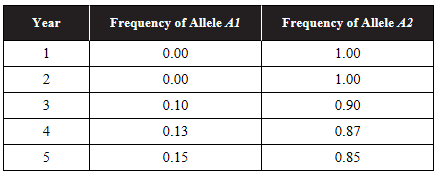
Which of the following is the most likely cause of the observed change in allele frequencies?
(A) artificial selection
(B) natural selection
(C) genetic drift
(D) gene flow
6. The following table shows the frequency of three genotypes (AA, Aa, and aa) in a population.

The environment of the population changes so that individuals with the Aa genotype are more likely to survive and reproduce. Predict what would most likely happen to the frequencies of the AA and aa genotypes after 10 generations in this environment.
(A) The frequencies of both the AA and aa genotypes would increase.
(B) The frequencies of both the AA and aa genotypes would decrease.
(C) The frequency of the AA genotype would increase, and the frequency of the aa genotype would decrease.
(D) The frequency of the AA genotype would increase, and the frequency of the aa genotype would be 0.
7. Which of the following is a characteristic of a population that is in Hardy-Weinberg equilibrium?
(A) small population size
(B) gene flow
(C) sexual selection
(D) no mutations
8. Ebony body color is an autosomal recessive trait in fruit flies. In a large, randomly mating population of fruit flies that is in Hardy-Weinberg equilibrium, the frequency of ebony body color is 21%. What is the percentage of the population with the homozygous dominant genotype?
(A) 29%
(B) 45%
(C) 54%
(D) 79%
Questions 9 and 10
For a genetic disease that appears in homozygous recessive (aa) individuals, individuals who are heterozygous (Aa) for the disease are resistant to infections by certain parasites.
9. If 19% of the individuals in a population have the genetic disease, what is the frequency of individuals who are resistant to the parasites? Assume the population is in Hardy-Weinberg equilibrium.
(A) 0.436
(B) 0.492
(C) 0.564
(D) 0.810
10. Over half of the individuals living in a population where a particular parasite is prevalent are heterozygous for a recessive allele (Aa). Further studies reveal that individuals who are heterozygous for the recessive allele are resistant to the parasite, while individuals who are homozygous dominant or homozygous recessive are susceptible to the parasite. If the parasite was totally eliminated from this area, predict what would happen to the frequencies of the AA, Aa, and aa genotypes.
(A) The frequencies of the AA and aa genotypes would increase, and the frequency of the Aa genotype would decrease.
(B) The frequency of the AA genotype would decrease, and the frequencies of the Aa and aa genotypes would increase.
(C) The frequency of the Aa genotype would increase, and the frequencies of the AA and aa genotypes would decrease.
(D) The frequency of the aa would increase, and the frequencies of the AA and Aa genotypes would decrease.
Short Free-Response
11. A scientist is studying the allele frequencies in a population over several generations to help determine if the population is undergoing evolution. The data are shown in the table.

(a) Describe why looking at allele frequencies over several generations could be used to determine if a population is undergoing evolution.
(b) Describe the changes in alleles A1 and A2 from generation 1 to generation 4.
(c) Evaluate the scientist’s hypothesis that this population is undergoing evolution based on the data available.
(d) Explain how the data would differ if individuals with the genotype A1A2 were more likely to survive than individuals with the genotype A1A1 or individuals with the genotype A2A2.
12. Wildfires in the western United States have drastically reduced the size of some animal populations and destroyed the habitats of other animal populations.
(a) Describe how wildfires can create the bottleneck effect in a population.
(b) 90% of the habitat of a spotted owl colony was destroyed by a wildfire. A small percentage of the surviving owl population migrated to a new habitat. Explain the type of genetic drift this illustrates.
(c) The banana slug, Ariolimax columbianus, lives in the redwood forest in the mountains near Santa Cruz, California. A wildfire in these mountains in the summer of 2019 divided the slug’s habitat with a large area of dry ash that the slugs cannot cross. Predict the effect this had on the genetic diversity of the banana slug population.
(d) Justify your prediction from part (c).
Long Free-Response
13. The California kangaroo rat, Dipodomys ingens, is considered an ecosystem engineer for its role in creating extensive burrowing systems that can change soil characteristics and provide habitats for other species. Fur color in D. ingens ranges from white to sandy to brown. Ecologists counted the number of D. ingens in an area before and five years after a large mudslide killed the majority of the kangaroo rats in the area. Data are shown in the table.
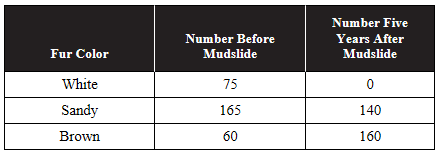
(a) Describe the probable cause of the change in frequency of fur color phenotypes in D. ingens after the mudslide event.
(b) Identify an appropriate control group for this study.
(c) Analyze the data with regard to how the mudslide affected the frequencies of fur color phenotypes in D. ingens.
(d) The burrows created by D. ingens provide habitats for many lizard species. In order to prevent future mudslides, retaining walls were constructed on the hillsides in the area, and the number of D. ingens in the area decreased by over 85%. Predict the effect of this on the lizard species diversity in the area, and justify your prediction.
Practice Questions
Multiple-Choice
1. In the 1950s, Stanley Miller performed an experiment to investigate the possible origin of the molecules required for life on Earth. Water vapor, methane, hydrogen gas, and ammonia were placed in a flask, and electric charges were applied to the system to simulate atmospheric conditions that were thought to be prevalent at the time. After many weeks, amino acids were produced in the system. Which of the following hypotheses is best supported by the results of this experiment?
(A) The molecules needed for life on Earth were brought to Earth by a meteorite.
(B) The molecules needed for life could have formed from inorganic compounds in Earth’s early atmosphere.
(C) The first molecules needed for life (that were formed in Earth’s early atmosphere) were RNA.
(D) The first molecules needed for life (that were formed in Earth’s early atmosphere) were carbohydrates.
2. Which of the following pieces of evidence best supports the hypothesis that birds are more closely related to reptiles than to other animals?
(A) Fossils of birds and reptiles are first seen in rock layers from the same time period.
(B) Birds and reptiles live in similar habitats and occupy the same trophic levels.
(C) Both birds and reptiles are the only animals with amniotic eggs.
(D) Molecular studies show that the DNA from birds has a greater degree of homology with the DNA from reptiles than with the DNA from other animals.
3. Generally, which type of data is considered most reliable when constructing phylogenies?
(A) fossil evidence, because it shows when species originated
(B) biogeography, because it shows organisms’ habitats
(C) morphological characteristics, because they show body structures
(D) molecular evidence, because it is less prone to convergent evolution or changes caused by geological events
Questions 4 and 5
Five new bacterial species were discovered in the Mariana Trench in the Pacific Ocean. The glyceraldehyde 3-phosphate dehydrogenase (GAPDH) gene was sequenced in all five species, and the number of nucleotide differences in the GAPDH gene among the five species is shown in the table.
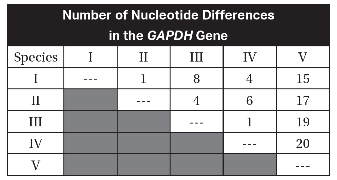
4. Which of the following cladograms is best supported by the data in the table?
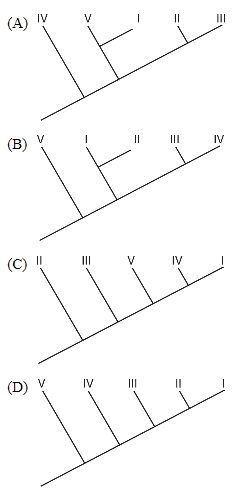
5. Based on the data in the table, which species is the outgroup?
(A) II
(B) III
(C) IV
(D) V
6. Which of the following best supports the existence of a common ancestor of all three domains of living organisms (Archaea, Bacteria, and Eukarya)?
(A) All living organisms perform glycolysis in their cytoplasm.
(B) All living organisms have membrane-bound organelles.
(C) All living organisms have linear chromosomes.
(D) All living organisms have genes that contain introns.
7. Some species of birds have unique bird songs that only attract members of the same species. This is an example of which type of reproductive isolation?
(A) behavioral
(B) gametic
(C) habitat
(D) mechanical
8. Orchids that belong to the genus Dendrobium will flower in response to certain weather stimuli. One species of Dendrobium flowers on the 8th day and closes on the 9th day after the weather stimuli, while another species of Dendrobium flowers on the 10th day and closes on the 11th day after the weather stimuli. This is an example of which type of reproductive isolation?
(A) habitat
(B) mechanical
(C) temporal
(D) hybrid breakdown
9. Which of the following is an example of mechanical reproductive isolation?
(A) The sea urchin species Strongylocentrotus purpuratus and Strongylocentrotus franciscanus both live in the same marine habitat and release their gametes simultaneously into the surrounding water. However, the gametes cannot form a zygote.
(B) In some snail species, the direction of the coil of the shell is controlled by a single gene. Snails with left-coiling shells cannot mate with snails with right-coiling shells because their copulating organs do not align.
(C) The fruit fly species Drosophila persimilis breeds in the early morning, and the fruit fly species Drosophila pseudoobscura breeds in the late afternoon.
(D) The bullfrog species Rana draytonii and Rana catesbeiana can mate and produce a zygote, but the zygote is not viable.
10. Tigers (Panthera tigris) and leopards (Panthera pardus) can mate and produce a zygote. The zygote will undergo cell division a few times, but this fails to result in the production of a viable embryo. This is an example of which type of reproductive isolation?
(A) gametic
(B) reduced hybrid viability
(C) reduced hybrid fertility
(D) hybrid breakdown
Short Free-Response
11. The following figure is a cladogram that represents the suspected ancestry of five species.
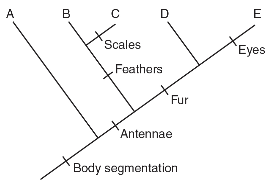
(a) Describe the characteristic(s) of the species that is the outgroup on this cladogram.
(b) Describe the similarities and differences in the characteristics present in species B and species D.
(c) A new species (X) is discovered, which has body segmentation, antennae, and fur but does not have eyes or scales. Construct a line that represents the ancestry of species X on the cladogram.
(d) Explain why species C is placed off of the same branch as species B and not the same branch as species D.
12. Two species of ground squirrels are separated by a river that they cannot cross. Genetic analyses of the two species of ground squirrels indicate that 99.3% of their DNA is homologous.
(a) Describe the type of reproductive isolation that separates the two species of ground squirrels.
(b) Explain how homology in DNA is used to determine ancestry.
(c) Due to a severe drought, the decision is made to divert water away from the river to a reservoir that supplies water for a nearby city, and the river separating the two species dries up. Predict the effect this will have on the two species of ground squirrels in the area.
(d) Justify your prediction from part (c).
Long Free-Response
13. The males of a particular species of bird attract mates with their bird songs. Male birds were observed, and the duration of their bird songs were recorded. The durations of the bird songs were classified into three groups: less than 120 seconds, 120–299 seconds, and 300–480 seconds. The number of females that approached the male birds within the 30-minute period, including during and immediately following the bird songs, was recorded. A graph of the data with 95% confidence intervals follows.

(a) Based on the data provided, make a claim about how the duration of the bird songs affects the number of females approaching the males.
(b) Describe the type of reproductive isolation that bird songs are an example of. Identify one more example of this type of reproductive isolation.
(c) Analyze the data in the graph, and determine whether there is a statistically significant difference in the number of females approaching males with bird songs in the 120–299 second range and the number of females approaching males with bird songs in the 300–480 second range.
(d) Predict the number of females that would approach a male with a bird song that is longer than eight minutes (480 seconds). Justify your prediction.




